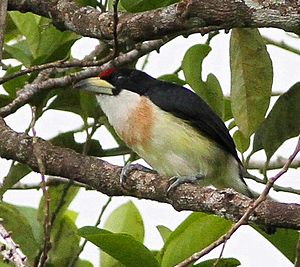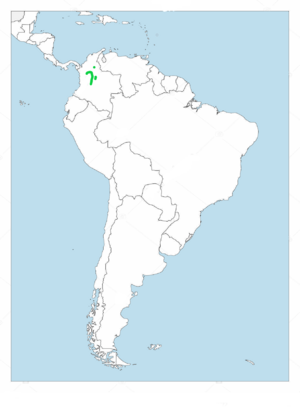White-mantled barbet facts for kids
Quick facts for kids White-mantled barbet |
|
|---|---|
 |
|
| Conservation status | |
| Scientific classification | |
| Genus: |
Capito
|
| Species: |
hypoleucus
|
 |
|
The white-mantled barbet (Capito hypoleucus) is a special kind of bird that lives only in Colombia. It belongs to the Capitonidae family, which includes birds known for their large beaks.
This bird makes its home in tropical forests on mountains, as well as in open areas like farmlands and plantations. Sadly, its home is shrinking, which puts the white-mantled barbet in danger.
Contents
About the White-Mantled Barbet
How Scientists Name It
Scientists give every animal a unique name, like a first and last name. This helps everyone know exactly which animal they are talking about. The white-mantled barbet was first described in 1897 by an English bird expert named Osbert Salvin.
Its scientific name, Capito hypoleucus, tells us a bit about it. Capito means "big-headed" in Latin, which fits because these birds have large heads. Hupo and leukos are Greek words that mean "beneath" and "white," referring to its white belly.
What It Looks Like
The white-mantled barbet is one of the biggest "New World" barbets, growing to about 19 centimeters (7.5 inches) long. Males usually weigh around 74.6 grams (2.6 ounces), and females are a bit lighter at 67.4 grams (2.4 ounces).
Here's how you can spot one:
- Its upper body is black, with faint pale lines on its neck and shoulders. These lines are hard to see because the bird often stays high up in tall trees.
- Its forehead and the top of its head are bright red.
- Its belly is white, sometimes with a yellowish tint and a touch of cinnamon color on its chest.
- It has red eyes.
- Its large, thick beak is yellowish.
- Its legs and feet are greenish-grey.
- Female barbets have a small black spot at the bottom of their lower beak.
Where It Lives
The white-mantled barbet lives in the central part of Colombia, specifically in the Middle Magdalena Valley. You can find it at different heights, from about 200 meters (650 feet) up to 1800 meters (5,900 feet) above sea level.
It prefers humid forests on mountain slopes. It also lives in areas where there's a mix of forest patches, pastures, younger forests that are growing back, and farms with fruit trees.
How It Behaves
These barbets usually search for food in pairs or small family groups. Sometimes, they even join groups of different bird species that are feeding together. They mostly stay high up in the forest canopy, which is the top layer of trees.
However, they will come down to lower branches or even into open areas to eat fruits from trees like mango and Cecropia.
Why It Needs Our Help
The number of white-mantled barbets is going down. The biggest reason for this is habitat loss, meaning their homes are disappearing.
The IUCN Red List, which tracks endangered species, lists the white-mantled barbet as "vulnerable." This means it's at high risk of becoming endangered. The "Red Book of the Birds of Colombia" goes even further, calling it "endangered." This is because the bird has already lost 60% of its natural home, and that loss continues.
What's causing this habitat loss?
- Illegal farming.
- Too much use of insecticides (chemicals that kill insects), which can harm the birds or their food sources.
- Small-scale gold mining, which destroys their forest homes.
See also
 In Spanish: Cabezón dorsiblanco para niños
In Spanish: Cabezón dorsiblanco para niños


